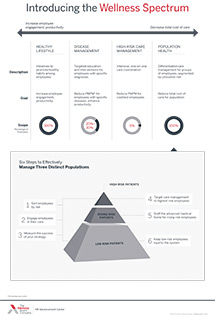Auto logout in seconds.
Continue LogoutMany Americans welcome the extra hour of sleep we get when we turn our clocks back in the fall—but the time change "can influence our health in unexpected ways," Allison Aubrey reports for NPR’s "Shots."
Understand the wellness spectrum—and promote healthy habits at work
Daylights savings time increases health risks
While a one-hour time change might not seem significant, our internal clocks can struggle to keep up with the sudden shift in time, according to Fred Turek, director of the Center for Sleep and Circadian Biology at Northwestern University. "[I]t turns out that the master clock in our brain is pretty hard-wired" to a consistent 24-hour cycle, he said. "The internal clock has to catch up, and it takes a day or two to adjust to the new time."
Our cells have time-regulating functions that keep our metabolism and sleep schedule on track, Aubrey reports. When we change the time we go to sleep, wake up, or eat, it can have negative effects on these functions.
On top of that, as the winter months approach, "[t]he [decrease] in daylight can throw off a lot of things including socialization and emotional rhythm," according to Sanam Hafeez, an adjunct assistant professor of psychology at Columbia University.
5 ways to prepare for less daylight
But experts say there are several steps one can take to combat the potential negative health effects of turning the clock back. Below we round up the five most-recommended actions.
- Go to bed earlier: Hafeez recommends going to sleep an hour earlier to maximize the daylight hours and beat the darkness in the early evenings—but that may require a change to pre-sleep habits. "Just record 'The Daily Show,' or whatever you watch at night," he said.
- Eat nutritious meals: We eat more when it's dark and cold, so winter is a great time to fill our bodies with more protein and good fats, according to Aubrey. Janet Polivy of the University of Toronto said we should add protein to our diets after turning the clocks back. For people who don't eat meat, plant-based proteins like tofu and nuts are great sources of omega-3 fatty acids. "One of the most basic ways that omega-3s help to regulate mood is by quieting down the [body's] response to inflammation," Joe Hibbeln of NIH, said.
- Eat a smaller dinner early in the day: The timing of eat our heaviest meal can contribute to weight gain, according to Aubrey. For instance, one study found that participants who ate their heaviest meal before 3 p.m. lost five pounds more than participants who ate dinner later at night. According to Aubrey, eating a heavy lunch and a small dinner, and limiting alcohol consumption can prevent weight gain while you adjust to the time shift.
- Join a group activity: There's a temptation to "hibernate" in the winter, according to Hafeez. Resist the urge to hunker down, and instead join group exercises and activities, Hafeez said. Staying active and in a social environment can help people stay engaged socially, which can prevent seasonal depression, Aubrey reports.
- Travel south: The winter days are darker and colder in the north, which means there is an increased chance of seasonal depression and social isolation, Aubrey reports. With this in mind, Turek said he "take[s] more trips to the southern part of the [United States] during the winter months," to take advantage of the sunnier and warmer days. "The closer you get to the equator, the more daylight there is" (Aubrey, "Shots," NPR, 11/3).
Understand the wellness spectrum—and promote healthy habits at work
Programs aimed at promoting healthy habits among employees are likely to lead to improved employee engagement and productivity—but they're unlikely to reduce the total cost of care. To do that, you'll need to take a population health approach.
Don't miss out on the latest Advisory Board insights
Create your free account to access 1 resource, including the latest research and webinars.
Want access without creating an account?
You have 1 free members-only resource remaining this month.
1 free members-only resources remaining
1 free members-only resources remaining
You've reached your limit of free insights
Become a member to access all of Advisory Board's resources, events, and experts
Never miss out on the latest innovative health care content tailored to you.
Benefits include:
You've reached your limit of free insights
Become a member to access all of Advisory Board's resources, events, and experts
Never miss out on the latest innovative health care content tailored to you.
Benefits include:
This content is available through your Curated Research partnership with Advisory Board. Click on ‘view this resource’ to read the full piece
Email ask@advisory.com to learn more
Click on ‘Become a Member’ to learn about the benefits of a Full-Access partnership with Advisory Board
Never miss out on the latest innovative health care content tailored to you.
Benefits Include:
This is for members only. Learn more.
Click on ‘Become a Member’ to learn about the benefits of a Full-Access partnership with Advisory Board
Never miss out on the latest innovative health care content tailored to you.

